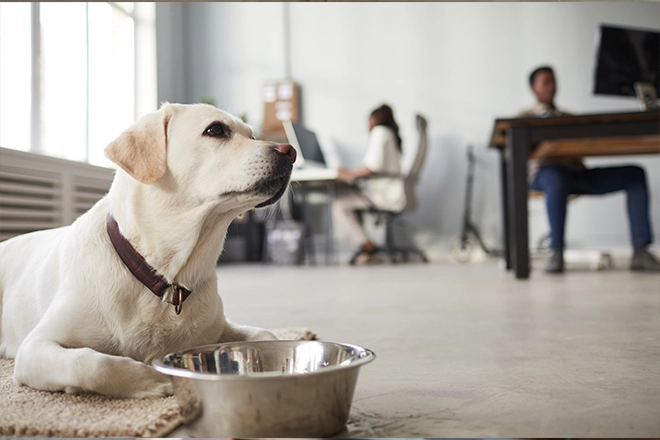For the Purrbabies


Explore how to responsibly bring your dog to work with tips on maintaining harmony in a pet-friendly office.

Introducing pets to one another anywhere can be stress-inducing, especially at the office. The office is a place of professionalism, and that applies to the pets that are allowed there as well. In order to safely and enjoyably introduce pets to one another and the work environment, you’ll want to follow a few steps to ensure that your dog is ready and how to facilitate these interactions going forward.
This is the most important question, and it should be answered honestly. We’d of course all love to bring our pets with us wherever we go, but not every dog can behave in the necessary ways for the setting, and that’s okay. There are several things to consider, like:
Then there are the questions you should ask yourself about your own habits:
If you find yourself answering that your pet may not be a great candidate—or you realize you yourself might not—that’s okay! It’s important to be honest because your dog’s safety and well-being should come before your desire to have them next to you.
If you’ve decided that you and your dog are both ready to take the plunge and become coworkers, there are a few further things to consider. The following steps are meant to ensure that the transition is safe and fun for you and your pup, but also your colleagues and the pets they may bring.
Pet policies will tell you everything you need to know about bringing a pet into the office. It can cover breed and size restrictions, where pets are allowed to be in the office, appropriate potty areas, what behavior is expected, and much more. Pet policies can get very specific or be broad, so if you have a question about your office pet policy, reach out to the administrator or office management to get clarity.
This is a super important step because offices are well within their rights to expect certain levels of health for the animals that visit. While we always recommend getting the core vaccinations for your pet, depending on their species, checking in with the vet before bringing your pet to the office can be a wealth of information.
Pets can carry illnesses that are easily transmissible to one another and to people, so a vet visit ensures that your pet is not only protected against those illnesses, but that they won’t give it to your coworkers or their pets.
Some employers may also request proof of vaccination or proof of good health so checking in with the vet can also double as an opportunity to get that documentation. Vets are also able to chat with you about how to best handle the experience of bringing a pet into the office so if you have any questions or concerns, feel free to ask them.
This is a courteous step, but one we recommend. Coworkers in the office are very much like roommates. You want to be respectful of their space and time as they are respectful to yours. As a heads up before bringing your pet into the office, let your coworkers know and hear them out if they have concerns. On the off chance that your desk neighbors don’t like dogs or are allergic, chat with office management about finding other options for seats.
Before you ever bring your dog to the office, you’ll want to make sure it’s a physically safe place. There are many hidden dangers that you might not think to look for, like plants, food, chemicals, chords, or other hazards that your dog could get into. The first place to start is at your desk. Make sure there isn’t anything on your desk that your dog could jump up and eat, and ensure that there’s nothing naughty they can get into if you step away.
But your desk isn’t the only place you should check out for safety. When walking around your office as a whole, take stock of any potential hazards or dangers. While you may not be able to make all those changes yourself, let management know and keep your pet away from those areas in the meantime.
A well-trained pet is the best pet to bring out in public. As a baseline, your dog should have great recall and be able to do things like sit, stay, come, leave it, and know a command to quiet barking. But before you bring your dog into the office, you’ll want to brush up on those skills and keep actively training your dog the entire time that you’re taking them into the office.
Training is convenient because you don’t have to worry so much about your dog getting into anything, but it's also a matter of safety. Dogs that have a great grasp on training are less likely to get hurt. Your dog will also be more likely to be allowed to stay on premises since pet policies often note that poor behavior can mean a pet is no longer welcome.
Make a list of everything your dog needs for the day and bring it to the office. At the most basic level, it’s things like food and water, but consider how your dog will be entertained. Do they need toys? How many? If you do bring toys, you’ll want to be sure they’re quiet since you don’t want to disturb your coworkers. You may also want to bring a pet bed (but be aware of its size since offices are usually tight on space) alongside treats and perhaps even a crate if space allows.
Offices can be loud and busy places that may come as a shock to your pet. Practice patience with them as they slowly get acquainted with their surroundings and all the people and animals that make up the office. If your pet has an accident or slips up on training, don’t freak out. It can be easy to feel embarrassed while at work, but your pet is trying their best to get a handle on things.
One thing to note is that if you notice your pet having a very hard time adjusting, they may not be right for the office. There’s nothing wrong with a pet that needs more peace and quiet or one that is simply more comfortable at home. It’s your job as the pet parent to do what’s best for them and their well-being.
Dogs are social creatures, but they can get into spats and tiffs like any other animal (including us humans!) When bringing your dog into the office, you have to be vigilant and pay attention to your dog and their behaviors, but also to other dogs around them. This can create extra stress for you as the owner, but in the end, it’s extremely important in keeping all pets safe.
Knowing the difference between dogs playing and showing signs of aggression should already be in your arsenal, but in case it’s not we have a few things to look out for. Dogs play fight a lot, but there is a distinct difference between playing and dogs that are gearing up to snap at one another.
For playing around, look for things like:
On the other hand, dogs that are showing signs of aggression often present with signs of:
There are sometimes situations where one dog is clearly showing signs of aggression while another seems happy to be there. If there is ever a sign of aggression, even if only from one dog, the situation should be diffused before anything escalates.
Anxiety in pets can have a ton of presenting symptoms, which is why understanding your dog and their personal limits can come in handy. If you bring your pet into the office and notice strange behavior coming from them, they could potentially be experiencing stress or anxiety that needs to be addressed. A few of the common signs of anxiety include panting, shaking, and excessive yawning. But there are also those less common symptoms that might throw you, such as decreased appetite, hiding, aggression, or excessive grooming.
As mentioned previously, not all dogs are a good fit for the office. That doesn’t mean your dog isn’t amazing or that you’re a bad pet parent. In fact, addressing your dog’s needs actually makes you a great owner.
We love dogs and we bet that your coworkers probably will too. But, you’ll want to make sure that you set boundaries for interactions with your pets. It’s a way to set yourself up for success and ensure the well-being of your pet. So, how do you do this?
Determine how you want people to interact with your pet. This can be looking at specific locations as being “okay” times to interact (think lunch break, potty breaks, etc.) or when you have a certain signal up on your desk like a green light for go and red light for maybe another time.
Dogs in the office should be pretty friendly and at least a little outgoing, but that doesn't mean that coworkers can touch your pet or distract them at will. Your decision on how people—and their pets—get to meet and play with your dog is your business. There may even be stipulations in the pet policy on appropriate times and places for pet play times that you can lean on.
If you’ve gone through this experience and your dog is well equipped to handle the stress of the office then that’s great! We’re glad you have a new furry coworker to help you destress during the workday. But if you worry that your pet isn’t cut out for corporate life, that’s okay, too. Just like people, dogs have their own personalities and needs that don’t always align with one another. At the end of the day, do what’s best for your dog.
If pets are allowed in the office, then the answer is no. However, bringing a pet without the express permission of the company you work for is a big no-no. If you want to bring your pet in, confirm with office management that it’s allowed and what you need to do to get ready for it.
One of the worst things you can do is to rush the process. Introducing pets is meant to be slow and steady allowing the dogs to get acquainted with one another. Don’t ignore signs of discomfort and anxiety and don’t force the situation if either dog shows signs of wanting to leave.
Focus on enrichment, exercise, attention, and creating a feeling of safety for your pup. What happens outside the office (mental stimulation and exercise) can go a long way in keeping your pet calm and mellow in the office.
We can’t speak to a specific breed of dog, but a dog that is relaxed, chill, and doesn’t have extensive needs is usually a great candidate for being an office dog.








